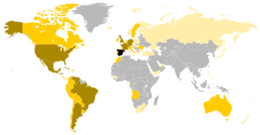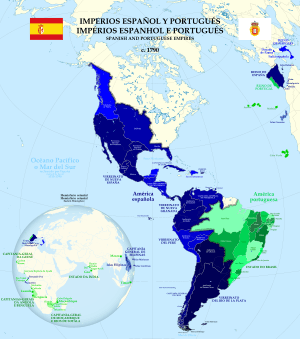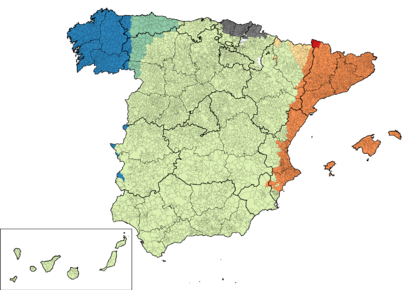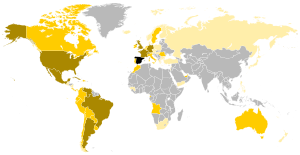Spaniards facts for kids
| Españoles (Spanish) | |
|---|---|
| Total population | |
| Spain nationals 41,539,400 (for a total population of 47,059,533) Hundreds of millions of Hispanic Americans of full or partial Spanish ancestry 840,535 were born in Spain 1,542,809 were born in the country of residence 265,885 others |
|
| Regions with significant populations | |
| Spain 41,539,400 (2015) | |
| Diaspora | |
| 404,111 (92,610 born in Spain) | |
| 303,000 (198,153 born in Spain) | |
| 192,766 (48,546 born in Spain) | |
| 182,631 (61,881 born in Spain) | |
| 181,181 (2020) (including de jure Spanish citizens that were not born in Spain) | |
| 136,145 (30,167 born in Spain) | |
| 117,523 (29,848 born in Spain) | |
| 108,858 (2,114 born in Spain) | |
| 108,314 (17,485 born in Spain) | |
| 103,247 (46,947 born in Spain) | |
| 63,827 (12,023 born in Spain) | |
| 56,104 (9,669 born in Spain) | |
| 53,212 (26,616 born in Spain) | |
| 35,616 (13,120 born in Spain) | |
| 30,683 (8,057 born in Spain) | |
| 27,489 (4,028 born in Spain) | |
| 24,485 (17,771 born in Spain) | |
| 21,974 (12,406 born in Spain) | |
| 20,898 (11,734 born in Spain) | |
| 18,928 (3,622 born in Spain) | |
| 18,353 (10,506 born in Spain) | |
| 16,482 | |
| 15,390 | |
| 12,375 | |
| 12,000 | |
| 9,311 | |
| 8,003 | |
| 6,794 | |
| 5,000 | |
| 3,380 | |
| 3,110 | |
| ~ 1,000 (2009) | |
| 2,450 | |
| 2,118–45,935 | |
| 1,826 | |
| 1,489 | |
| 1,007 | |
| Languages | |
| Spanish (see languages) | |
| Religion | |
| Predominantly Catholic Christianity Minority Irreligion |
|
Spaniards are people who come from Spain. Spain has a rich and complex past. This history has created many different regional groups and languages.
The main language spoken across the country is Spanish. However, other languages are also important. These include Basque, which is a very old language unique to the region. Other languages like Catalan and Galician come from Latin, just like Spanish.
Many people outside Spain have Spanish ancestors. They share parts of the Hispanic culture. A large number of these people live in Hispanic America in the Western Hemisphere.
The Roman Republic took control of the Iberian Peninsula (where Spain is) a long time ago. They called it Hispania. The Romans brought their language, Latin, which changed the local languages. This is why most languages in Spain today, except Basque, grew from Latin.
After the Roman Empire ended, different groups from Central Europe moved into the Iberian Peninsula. The Visigoths eventually united most of the area. Later, in the early 700s, the Umayyad Islamic Caliphate conquered the Visigothic Kingdom. This led to a period called al-Andalus, where Muslim rule was strong.
Over many centuries, Christian kingdoms in the north slowly took back land. This period is known as the Reconquista. It ended in 1492 when the last Muslim kingdom, Granada, was conquered. In the same year, Christopher Columbus arrived in the New World. After the Reconquista, some religious groups like Jews and Muslims were forced to leave Spain.
The kingdoms of Castile and Aragon united in the late 1400s. This is often seen as the start of Spain as a single country. Spain then built one of the largest empires in history. This empire spread Spanish culture and language around the world. Today, Spanish is the second most spoken native language globally. This time was also a "Golden Age" for arts and literature, with famous painters like Diego Velázquez and the book Don Quixote.
In recent times, Spain's population has become more diverse. Many people have moved to Spain from other countries. From 2000 to 2010, Spain had one of the highest rates of new immigrants.
Contents
A Look at Spain's Past
Ancient Peoples and Roman Times


The first modern humans lived in Spain around 35,000 to 40,000 years ago. Later, groups like the Iberians settled along the Mediterranean coast.
Around the Iron Age, the Celts arrived in Spain. Some groups, like the Celtiberians, mixed Celtic and Iberian cultures. Other groups, like the Tartessians, developed their own culture influenced by the Phoenicians.
Trading groups like the Phoenicians, Greeks, and Carthaginians also set up colonies. The Second Punic War was fought between the Carthaginians and Romans mainly in what is now Spain.
The Roman Republic conquered the Iberian Peninsula in the 2nd and 1st centuries BC. They introduced Latin, which became the base for most modern Spanish languages. Important Roman figures like Emperor Trajan were born in Roman Hispania.
After the Romans, Germanic tribes like the Vandals and Suebi arrived. The Visigoths became the main power and ruled for three centuries. They adopted Roman culture and Christianity.
The Middle Ages and Muslim Rule
After two centuries of Visigothic rule, a Muslim force invaded the Iberian Peninsula in 711. This army was mostly made up of Berbers and Arabs. Only a small mountainous area in the north remained independent. This area later became the Christian Kingdom of Asturias.
Muslim Iberia was called Al-Andalus. It became a powerful center of learning and culture. However, the Muslim rule eventually broke into smaller states called taifas. These states were often weak.
Christian kingdoms in the north, like Navarre, León, Portugal, Castile, and Aragon, grew stronger. They slowly began to conquer land from the Muslim states. This long process was called the Reconquista.
In 1469, Ferdinand of Aragon and Isabella of Castile married. This united their kingdoms. They worked together to conquer the last Muslim state, the Emirate of Granada. In January 1492, Granada surrendered. This was the same year Christopher Columbus sailed to the New World.
Spain also conquered the Canary Islands between 1402 and 1496. The native people there, the Guanches, mixed with Spanish settlers.
The union of the Christian kingdoms led to the formation of the Spanish state we know today. This helped create a Spanish identity based on the Spanish language and Catholicism. However, Spain remained diverse in its cultures, languages, and religions.
Many Jews were forced to convert to Catholicism or leave Spain in 1492. Later, in the early 1600s, many Moriscos (Muslims who had converted to Catholicism) were also expelled. These expulsions had a big impact, especially in eastern Spain.
The Islamic legacy in Spain is still visible today. Famous buildings like the Alhambra of Granada and the Cordoba Mosque are examples of amazing Islamic architecture.
Spanish Colonialism and Migration
In the 1500s, many Spaniards moved to the Americas after the conquest of new lands. By the 1800s, millions of Spaniards had settled there. They mainly went to places like Mexico, Peru, Argentina, and Cuba.
After the Spanish Civil War, about 500,000 Spanish refugees went to France. From 1961 to 1974, many Spaniards also moved to other parts of Western Europe for work.
Spain has recently become more diverse due to immigration. From 2000 to 2010, Spain had one of the highest immigration rates in the world. Immigrants now make up about 10% of the population. However, an economic crisis from 2008 to 2015 led to fewer immigrants and more people leaving Spain.
People and Regions of Spain
Different Nationalities and Regions
Spain is home to many different groups of people. These include the Andalusians, Castilians, Catalans, Valencians, and Balearics. The Catalans, Valencians, and Balearics speak Catalan, which is a unique Romance language.
The Basques live in the Basque Country and northern Navarre. They speak Basque, which is a very old language not related to other European languages. The Galicians speak Galician, which comes from an old language called Galician-Portuguese.
Many Spaniards value the different cultures within their country. Some regions, like Catalonia, the Basque Country, or Galicia, have strong feelings of national identity.
Here are some of the different groups and regional identities in Spain:
- Andalusian people
- Aragonese people
- Asturian people
- Balearic people
- Basque people
- Canary Islanders
- Cantabrian people
- Castilian people
- Catalan people
- Extremaduran people
- Galician people
- Leonese people
- Valencian people
Romani People in Spain
Spain has one of the largest communities of Romani people, also known as "gypsies." The Spanish Roma belong to a group called Iberian Kale. They were once nomadic, meaning they traveled a lot. They first arrived in Spain in the 1400s.
It's hard to get exact numbers, but it's thought that about one million Romani people live in Spain. Most Spanish Roma live in Andalusia. They have often blended into society more easily there than in other parts of the country.
Recent Immigration to Spain
Spain's population has become more diverse because of recent immigration. From 2000 to 2010, Spain had one of the highest rates of new immigrants in the world. Immigrants now make up about 10% of the population.
Since 2000, over 3 million immigrants have moved to Spain. They come from many places, including Europe, Latin America, Asia, North Africa, and West Africa.
Languages of Spain
The main language in Spain is Spanish (also called castellano or español). About 74% of people speak it. Other important languages include Catalan (17%), Galician (7%), and Basque (2%).
Spanish is the official language of the whole country. However, Catalan, Galician, and Basque are also official in certain regions. Other languages like Asturian and Aragonese are recognized but not official.
Spanish is a Romance language, meaning it comes from Latin. It has many words from Arabic because of the long period of Muslim rule. About 4,000 Spanish words come from Arabic. Spanish also has influences from other Romance languages like French and Italian.
Around 35.6 million people speak Spanish as their first language in Spain. Most people who speak other languages in Spain also speak Spanish. This means almost everyone in Spain's population of 46 million can speak Spanish.
Spanish was brought to the Americas by Spanish explorers and settlers starting in 1492. Today, over 400 million people speak Spanish as their native language. It is spoken in most countries in the Americas, from the Southwestern United States down to Tierra del Fuego.
A special form of Spanish, called Judaeo-Spanish or Ladino, is still spoken by descendants of Jews who left Spain in 1492. There is also a Spanish creole language called Chabacano spoken in the Philippines. It mixes Spanish with local languages like Tagalog.
Religion in Spain
The largest religion in Spain is Roman Catholicism. However, the number of Catholics has been going down. In 2013, about 71% of Spaniards said they were Catholic. About 25% said they had no religion or were atheists. By 2019, the number of Catholics was down to 69%.
Spaniards Around the World
Outside of Europe, Latin America has the largest number of people with Spanish ancestors. These include people who are fully or partly of Spanish descent.
Many countries have large populations with Spanish roots. For example, in Mexico, a large percentage of the population has Spanish ancestry. The United States also has many people who identify with direct Spanish ancestry. Other countries like Venezuela, Brazil, and Colombia also have significant populations with Spanish heritage.
Images for kids
Sources
- Castro, Americo. Willard F. King and Selma Margaretten, trans. The Spaniards: An Introduction to Their History. Berkeley, California: University of California Press, 1980. ISBN: 0-520-04177-1.
- Chapman, Robert. Emerging Complexity: The Later Pre-History of South-East Spain, Iberia, and the West Mediterranean. Cambridge: Cambridge University Press, 1990. ISBN: 0-521-23207-4.
- Goodwin, Godfrey. Islamic Spain. San Francisco: Chronicle Books, 1990. ISBN: 0-87701-692-5.
- Harrison, Richard. Spain at the Dawn of History: Iberians, Phoenicians, and Greeks. New York: Thames & Hudson, 1988. ISBN: 0-500-02111-2.
- James, Edward (ed.). Visigothic Spain: New Approaches. Oxford: Clarendon Press, 1980. ISBN: 0-19-822543-1.
- Thomas, Hugh. The Slave Trade: The History of the Atlantic Slave Trade 1440–1870. London: Picador, 1997. ISBN: 0-330-35437-X.
- The genomic history of the Iberian Peninsula over the past 8000 years (Science, 15 March 2019, Vol. 363, Issue 6432, pp. 1230-1234)
See also
 In Spanish: Pueblo español para niños
In Spanish: Pueblo español para niños








